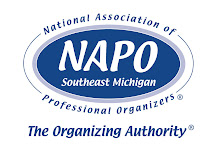Hoarding gets a lot of media attention these days, and people have turned to the professional organizing industry for assistance. Why professional organizing? Because most people think that hoarding is a type of disorganization—which it’s not. The National Association of Professional Organizers in Michigan wants to share five common myths about hoarding.
1) MYTH: Hoarding is extreme disorganization. TRUTH: Hoarding and disorganization are two distinct things. Some people who hoard are in fact quite organized. Hoarding is not about the stuff—it’s about the person’s attachments to the stuff. Some, but not all, professional organizers have taken special training to help hoarding clients who are ready to reduce their belongings.
2) MYTH: People who hoard don’t mind clutter and dirt. TRUTH: Many are so bothered by it that they must mentally block it out. When the person is no longer able to look past the mess, it might be a sign that s/he wants to change.
3) MYTH: A weekend “cleanout” is the best way to address hoarding. TRUTH: For many people, a forced or too-fast cleanout is just as traumatizing as involuntary surgery. Hoarding is a coping mechanism, and no competent therapist would support stripping it away before healthier ways of coping are established. It takes time—months, sometimes years—to help a hoarding person humanely.
4) MYTH: People who hoard can’t stop. TRUTH: As with every compulsive behavior, most people can reduce the habit when they become committed to changing and when they receive appropriate (see myth #3) assistance and support.
5) MYTH: People who hoard are severely mentally ill. TRUTH: Not all of them, and probably not even the majority. Many people who hoard have had a traumatic experience or survived a period of terrifying instability, and they need a therapist’s help to process those experiences. However, the risk of re-traumatizing the person is very high when well-meaning “helpers” believe these and other myths about hoarding. The person can be driven to more severe mental illness by inappropriate interventions.
For more information on getting organized, visit www.NapoMichigan.com.
Article submitted by Chapter member and Past President, Debbie Stanley, LLPC, NCC, CPO-CD.
skip to main |
skip to sidebar

NAPO Michigan Blog / Media Center
The Michigan Chapter of the National Association of Professional Organizers invites you to explore this blog so you can be informed of the latest news, events and trends in the organizing industry.
Networked Blogs
View Articles by Type
- chapter event (1)
- chapter news (2)
- meeting speakers (7)
- organizing tips (48)
View Articles by Topic
- January organizing tip (25)
- back to school (8)
- basement (2)
- clutter (6)
- estate organizing (1)
- gift giving tips (2)
- holiday planning (6)
- kitchen (4)
- paper management (6)
- photo organizing tips (2)
- planning tips (5)
- routines (4)
- schedules (4)
- tech tips (4)

About the Michigan Chapter
We are Michigan's leading network of professionals who are dedicated to helping individuals and businesses create order and efficiency in their lives. Our Chapter members include: professional organizers, organizing consultants, coaches and trainers, productivity experts, speakers and authors, retailers and manufacturers of organizing products, and related service providers.
We invite you to explore our blog and connect with us!
We invite you to explore our blog and connect with us!
More Info
For more information on our Chapter, our members or getting organized, visit http://www.napomichigan.com/.
Article Contributors
Carolyn Anderson-Fermann, Mary Lynn Badr, Theresa Brune, Karen DeClark, Cynthia Gentit, Cindy Greenleaf, Mal Hillman, Betty Huotari, Trish Krebs, Donna Kuper, Ann Marie Moore, Stacy Rafalko, Deb Stanley, Debbie Tebbe, Cindy Tyner, Nancy Varbedian, Angie Weid, Rita Wilhelm.
Copyright © 2011 National Association of Professional Organizers, Michigan Chapter.. Powered by Blogger.
